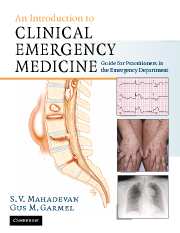Book contents
- Frontmatter
- Contents
- List of contributors
- Foreword
- Acknowledgments
- Dedication
- Section 1 Principles of Emergency Medicine
- Section 2 Primary Complaints
- 9 Abdominal pain
- 10 Abnormal behavior
- 11 Allergic reactions and anaphylactic syndromes
- 12 Altered mental status
- 13 Chest pain
- 14 Constipation
- 15 Crying and irritability
- 16 Diabetes-related emergencies
- 17 Diarrhea
- 18 Dizziness and vertigo
- 19 Ear pain, nosebleed and throat pain (ENT)
- 20 Extremity trauma
- 21 Eye pain, redness and visual loss
- 22 Fever in adults
- 23 Fever in children
- 24 Gastrointestinal bleeding
- 25 Headache
- 26 Hypertensive urgencies and emergencies
- 27 Joint pain
- 28 Low back pain
- 29 Pelvic pain
- 30 Rash
- 31 Scrotal pain
- 32 Seizures
- 33 Shortness of breath in adults
- 34 Shortness of breath in children
- 35 Syncope
- 36 Toxicologic emergencies
- 37 Urinary-related complaints
- 38 Vaginal bleeding
- 39 Vomiting
- 40 Weakness
- Section 3 Unique Issues in Emergency Medicine
- Section 4 Appendices
- Index
11 - Allergic reactions and anaphylactic syndromes
Published online by Cambridge University Press: 27 October 2009
- Frontmatter
- Contents
- List of contributors
- Foreword
- Acknowledgments
- Dedication
- Section 1 Principles of Emergency Medicine
- Section 2 Primary Complaints
- 9 Abdominal pain
- 10 Abnormal behavior
- 11 Allergic reactions and anaphylactic syndromes
- 12 Altered mental status
- 13 Chest pain
- 14 Constipation
- 15 Crying and irritability
- 16 Diabetes-related emergencies
- 17 Diarrhea
- 18 Dizziness and vertigo
- 19 Ear pain, nosebleed and throat pain (ENT)
- 20 Extremity trauma
- 21 Eye pain, redness and visual loss
- 22 Fever in adults
- 23 Fever in children
- 24 Gastrointestinal bleeding
- 25 Headache
- 26 Hypertensive urgencies and emergencies
- 27 Joint pain
- 28 Low back pain
- 29 Pelvic pain
- 30 Rash
- 31 Scrotal pain
- 32 Seizures
- 33 Shortness of breath in adults
- 34 Shortness of breath in children
- 35 Syncope
- 36 Toxicologic emergencies
- 37 Urinary-related complaints
- 38 Vaginal bleeding
- 39 Vomiting
- 40 Weakness
- Section 3 Unique Issues in Emergency Medicine
- Section 4 Appendices
- Index
Summary
Scope of the problem
In the emergency department (ED), it is not uncommon to compare the pain of minor procedures to a “bee sting.” However, the estimated prevalence of acute anaphylactic reactions to insect stings is as high as 0.8% of the US population, resulting in about 40 deaths annually. In the broader scheme, anaphylaxis from any cause has been estimated to occur at rates as high as 1 in every 3000 patients, with 500 deaths per year in the US. Despite the predominantly subtle presentations, lethal allergic reactions do occur. Failure to rapidly diagnose and treat these conditions will likely result in untoward outcomes. Therefore, it is imperative that emergency physicians have a solid understanding of allergic reactions and anaphylaxis. It is important to remember that the symptoms of allergic reactions occur on a spectrum – from mild cases of pruritis to cardiovascular collapse.
Pathophysiology
The term “anaphylaxis” comes from the Greek words for “against” and “protection.” The mechanism begins when the body produces immunoglobulin E (IgE) during initial exposure to an antigen. On subsequent exposure, IgE binds to mast cells, causing release of vasoactive products. These products, histamine being chief among them, lead to smooth muscle spasm, bronchospasm, mucosal edema, angioedema, and increased capillary permeability. Such reactions are generally immediate; however, it has been suggested that mast cells or basophils can also release new mediators in a delayed fashion, which results in a second phase of symptoms.
- Type
- Chapter
- Information
- An Introduction to Clinical Emergency MedicineGuide for Practitioners in the Emergency Department, pp. 171 - 178Publisher: Cambridge University PressPrint publication year: 2005



